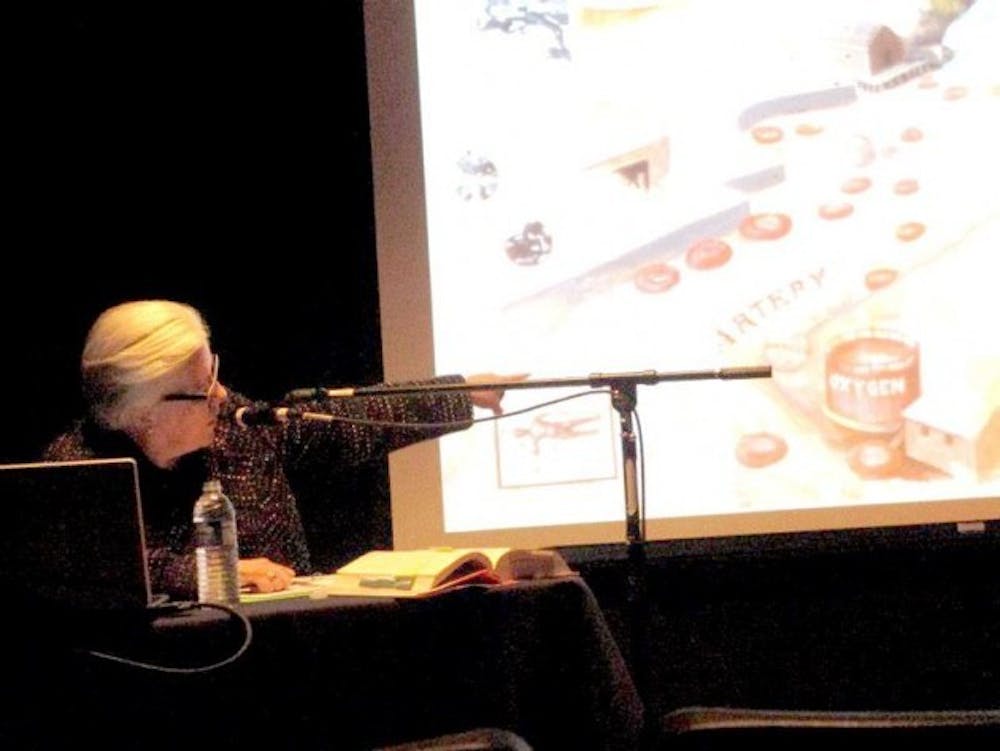An intimate room, a few chairs and a photo of a little boy dressed in plaid projected on a back wall. The image was assaulted by words that will call for his death, his repentance and his violent degradation - the boy sees his grim future.
"All this will begin to happen in one or two years when he discovers he desires to place his naked body on the naked body of another boy."
On Friday night, Hallwalls Contemporary Arts Center presented author Cynthia Carr and her critically acclaimed biography Fire in the Belly: The Life and Times of David Wojnarowicz. The book recounts the life and work of Wojnarowicz, an artist who spent his life battling what he called "the pre-invented world" and the illusions that surround society based on structure, government control and faith, among other things.
Wojnarowicz was born in 1954 and brought up in a rough home. He was self-educated and barely graduated high school. In the early '70s, he lived on the streets of New York City and sometimes prostituted himself.
He originally began as a poet, something he kept a secret according to Carr, and switched to visual art after his nine-month stay in France. Wojnarowicz returned to New York City after a brief love affair with a man in France and created a whole series of photographed friends in Rambo masks. It was when he got into stencil work that he met Peter Hujar, his lifelong friend and supporter.
"I felt like the central thing David was working on his entire life was 'How much of myself can I reveal,'" Carr said.
Wojnarowicz then produced a series of 23 alien heads with "a couple of extras," that he titled Metamorphosis. The piece was iconography based on his feelings of isolation, and he created a progression as each head became more distressed. He created 23 heads because there were 23 genes in a chromosome, according to Carr.
After returning from a trip to Mexico in 1986, Wojnarowicz's close friend Hujar was diagnosed with HIV. At this time, Wojnarowicz was working on editing his "A Fire in My Belly" series and beginning his work on the pre-invented world, a project that would consume the rest of his life.
When Hujar died, Wojnarowicz began painting portraits himself, soon before facing his own destiny.
Wojnarowicz was diagnosed with HIV in 1988 and died from complications of AIDS in 1992, but didn't go down without a fight - he had many confrontations with government officials before his death.
In Mexico, he had filmed fire ants crawling over various objects and, most notably, a crucifix. To him, the ants represented humans. The crucifix, watch faces, coins and other objects he used represented false structures in society. To others, the images represented an attack on religion and sparked a media storm around Wojnarowicz.
"The film is very intense. I would say it is about suffering," Carr said. "Certainly not an attack on Christmas."
The "Ant on the Crucifix Controversy," as Carr calls it, is how many were introduced to Wojnarowicz. Small segments of religious reference, gay media, children and violence were often referenced within his work.
When Wojnarowicz was contacted to write an essay for art gallery and bookstore Artists Space in 1989, he called out two politicians notorious for their thoughts on homosexuality and AIDS, North Carolina Senator Jesse Helms and noted Republican William Dannemeyer.
In his essay, Wojnarowicz called out the homophobic politicians who prevented government funds in AIDS awareness or assistance and even went as far as glorifying the deaths of the two, causing even more controversy for the artist.
Hallwalls celebrates Wojnarowicz as an emotional man drabbled with his own childhood and surrounded by a disease misunderstood by many in the '80s.
Edmund Cardoni, the executive director at Hallwalls, introduced Carr and her research of Wojnarowic's life at the beginning of the night.
"She lived in that community that whole time that [Wojnarowicz] was active, so she knew all the people personally, was part of that scene, chronicled that scene in all its vibrancy, in all the tragedy of AIDS, and the impact it had on that community at that time," Cardoni said. "And all the culture wars in the late '80s and early '90s. She wrote about that, too, and David Wojnarowicz was very much at the center of that in many cases."
Cynthia Carr's Fire in the Belly: The Life and Times of David Wojnarowicz can be found at Talking Leaves on Main Street.
Email: arts@ubspectrum.com





